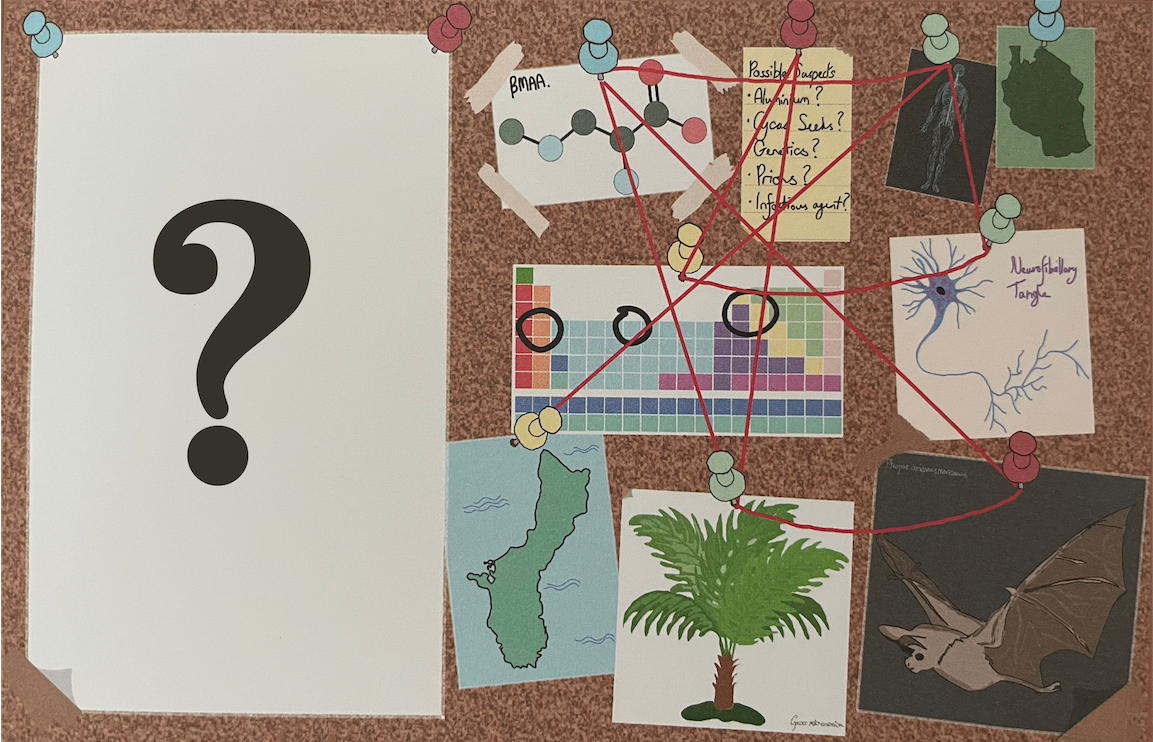The mystery behind an old disease. Artwork by Sam Jones, The Oxford Scientist.
This article was originally published in the Oxford Scientist’s Print edition, Mysteries, in Hilary Term 2023. You can read more of our Print articles here.
Guam has one of the richest histories in the Mariana Islands in the western Pacific Ocean. Its first inhabitants, the Chamorro, arrived in 2000 BCE and made the place their own. They built houses out of stone and brick, cultivated rice, and explored the neighbouring Caroline Islands through their signature canoe, the sakman. At 20 miles per hour, the sakman could beat the Oxford traffic.
These cultural practices were robbed by the Spanish conquistadors in the 1500s and the war that ensued killed and displaced thousands of Chamorro. To make matters worse, in 1823 eight people died from a paralytic disease—the first few in almost 1000 cases of a bizarre condition that exploded in the 1900s. Its sufferers presented a dichotomous range of symptoms: either paralysis, named “lytico”, or a Parkinsonian-like presentation called “bodig”. In either case, the disease almost always proved fatal.
Guam‘s first inhabitants explored the neighbouring islands through their signature canoe, the sakman. At 20 miles per hour, the sakman could beat the Oxford traffic.
By the 1950s, “lytico-bodig” became known as amyotrophic lateral sclerosis-Parkinson’s disease complex (ALS-PDC) within the scientific community. It became the leading cause of adult Chamorro death from 1945 to 1956, and the new “it thing” in neuroscience, where scientists hoped that it might shed light on the secrets of another neurodegenerative disease—Alzheimer’s.
As the disease clustered within families, many suggested that it was hereditary. However, this did not explain why some people who emigrated out of Guam as children did not develop lytico-bodig, whilst young immigrants did. This led many to wonder whether the cause was environmental.
One popular theory linked lytico-bodig with flour that was made from the seeds of Cycas micronesica. C. micronesica is a species of cycad; a lush, sprawling fusion between a cactus and a palm, that has existed on Guam for over 9,000 years. Cycad flour is rich in an amino-acid called BMAA, which poisons neurons by depleting them of an antioxidant called glutathione.
The rise and fall of lytico-bodig coincided with changes in the Chamorro diet. Cases began to fall in the 1950s, when industrialisation meant that many people in Guam switched to diets which lacked cycad flour. Meanwhile, results from experiments were conflicting. Direct treatment of fresh human brain specimens with BMAA killed few neurons, whilst feeding BMAA to macaques gave them lytico-bodig-like symptoms. However, many were critical of the evidence from the macaque experiments, arguing that the BMAA was at much higher levels than in cycad flour.
Then in the early 2000s several scientists, including Oliver Sacks, postulated that consumption of flying foxes, a delicacy on Guam, led to biomagnification of BMAA in humans. Flying foxes feed on cycad plants and accumulate BMAA at 50- to 100-fold higher concentrations in their fat, making them a more compelling source of BMAA.
Aside from the BMAA theory, other arguments associate lytico-bodig with abnormal mineral levels. The soil on Guam is low in calcium, and some suggest that changes in diet led to a sudden uptake of calcium which can form damaging mineral deposits in nervous tissue.
More evidence supporting the mineral theory lies in villages of the Kii peninsula in Japan, where the soil is similarly deficient in calcium and where a lytico-bodig-like condition has been observed. However, these Japanese patients were found to have a defect in the C9orf72 protein which protects neurons from DNA damage, whereas the patients on Guam lacked this mutation. Furthermore, sufferers of lytico-bodig do not generally have many other symptoms of calcium disturbances.
While no single responsible gene was found, genetic studies have revealed an oddly high-density of alleles on Guam that are associated with the neurodegenerative conditions.
Most now suspect that the disease is caused by a mixture of abundant environmental toxins and a genetic predisposition. Indeed, while no single responsible gene was found, follow-up genetic studies have revealed an oddly high-density of alleles on Guam that are associated with the development of neurodegenerative conditions.
Fortunately, the case numbers of lytico-bodig are falling, and with that it becomes less likely that we will ever figure out its cause. Whilst lytico-bodig is a scientific mystery, it is also a story of those who watched their close family members suffer, and fear that the same fate might await them too. As lytico-bodig fades from memory, traditional practices such as canoe building are being re-discovered by people on Guam—a celebration of the massive history of a small, Pacific island.





